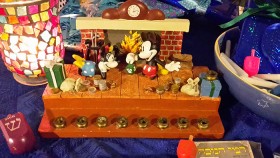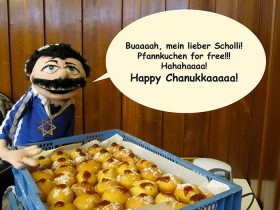— the Hanukkah Message?

Mice with a vice
Photo: CC-BY Michal Friedlander
I have been using the same Hanukkah lamp for nearly 20 years. I find it aesthetically-challenging and totally impractical: it is difficult to clean and the candles fall out. Yet I persist in using it because it provokes me to think. When I put the illuminated, figurative lamp on the windowsill to publicly “proclaim the Hanukkah miracle of light,” the same three questions always resurface in my mind: “Who designed this lamp?,” “What were they thinking?,” and, “Are Mickey and Minnie Mouse actually Jewish?” → continue reading

One of the hand puppets from Shlomit Tulgan’s bubales family saying “Oooh, my oh my! Hotcakes for free!!!”
CC-BY Shlomit Tulgan
I was asked recently if I could write something about how I celebrate Hanukkah in my own circle of family and friends. It occurred to me that the last time I spent Hanukkah with friends or with my parents was quite awhile back. I rummaged around through old photos until I found a picture of me with my father in 1988, lighting our Hanukkah candelabrum: we had just applied for political asylum in West Berlin and were allowed to stay with friends, so we didn’t have to remain longer in refugee quarters. For me back then, Hanukkah was a personal, family thing. → continue reading

Postcard “Kol Nidre outside Metz 1870,” gift of Liselotte Eschenbach, more information on the object in our German-language online collection
© Jewish Museum Berlin, photo: Jens Ziehe
On 23 September of this year, we will celebrate Yom Kippur. As always on the eve of the Day of Atonement, synagogues will be overflowing with people anxiously waiting for the singing of Kol Nidre, a prayer (in form of a declaration) in Aramaic and Hebrew that implores God to forget “all vows, obligations, oaths or anathemas, pledges of all names, which we have vowed, sworn, devoted, or bound ourselves to,” either from the past year or for the year to come. This somewhat surprising imploration has caused many prominent Jewish thinkers to question the prayer’s validity. → continue reading


